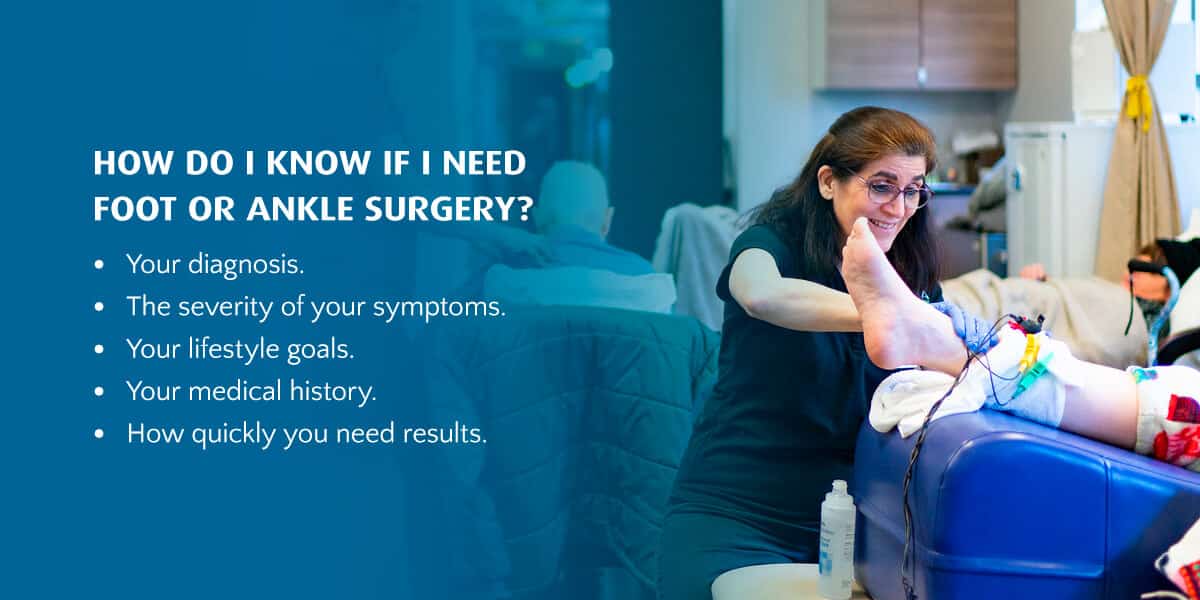Nobody wants to get foot surgery, but that isn’t a big secret. Patients commonly express that sentiment. However, patients also commonly avoid visiting the doctor for foot or ankle pain until months or years have passed. The usual reason? They are worried their doctor is going to tell them they need surgery.
Unfortunately, the decision to delay treatment often makes surgery necessary, as earlier intervention might have prevented the need for it.
With that in mind, you may be surprised that most foot doctors don’t want you to get foot surgery either! If you don’t need surgery, most doctors will avoid it at all costs. Surgery is almost always a last resort — not a first approach. That’s something every patient who experiences foot and ankle pain should know! If a doctor believes your foot or ankle condition can be treated noninvasively through conservative measures, they will exhaust those options first.
Can you get surgery on your Feet?
Sometimes conservative treatments just aren’t going to solve your foot problems — or at least not well enough to get you back to the lifestyle you love and deserve. So, there are times when surgery is essential. Keep reading to learn about foot surgery becomes necessary!

How Do I Know If I Need Foot or Ankle Surgery?
Unfortunately, there’s not always a straightforward answer that universally applies to the question of knowing when you need foot surgery. Many different factors influence your need for foot surgery or lack thereof, including:
- Your diagnosis.
- The severity of your symptoms.
- Your lifestyle goals.
- Your medical history.
- How quickly you need results.
With those caveats in mind, doctors use two main checkboxes to determine if you need foot or ankle surgery. If you check them both, your doctor will probably start to take surgery much more seriously as an option.
First Checkbox: Your Pain Has Become a Significant Obstacle Affecting Your Lifestyle.
Everyone has a unique lifestyle, so whether or not their pain presents a significant obstacle to that lifestyle varies with each person. Essentially, this checkbox is about determining whether you can live a full, meaningful life the way you want to.
Now, if your pain is a daily occurrence that limits your ability to get through the everyday activities we all perform — going to work, taking care of the kids, going shopping or cleaning the house — then the need for surgery becomes more likely.
On the other hand, maybe your day-to-day activities aren’t significantly affected, but specific recreational activities that you enjoy, such as running or playing tennis, lead to a lot of pain. In this case, surgery is also an option if those activities are an important part of your preferred lifestyle and you’re looking for an effective way to restore your ability in those activities. This reason to pursue surgery commonly applies to athletes who’ve experienced an injury to their foot or ankle.
Second Checkbox: Conservative Treatment Options Haven’t Been — Or Won’t Be — Effective
As you’ll commonly hear at Foot & Ankle Surgical Associates, surgery is a last resort. The preferred approach to treat painful conditions at Foot & Ankle Surgical Associates is noninvasive, conservative treatment options — an approach that most patients appreciate and agree with!
Another critical thing to remember is that the sooner you seek medical attention for your foot pain, the more likely you can avoid surgery.
Many foot conditions progressively worsen if you allow them to linger without treatment. Ignoring a bunion, hammertoe or aching heel is not a recommended solution. Moreover, once your condition passes a certain threshold, noninvasive therapies may no longer be a practical option. If you’ve tried conservative treatment options and they’ve proven ineffective, your foot doctor may recommend considering surgery.
Some examples of conservative treatments include:
- Physical therapy.
- Non-steroidal anti-inflammatory drugs (NSAIDs), such as Advil, Aspirin or Aleve.
- Acupuncture.
- Massage therapy.
- Custom orthotics.
- Hot and cold therapy.
What Happens During and After Foot or Ankle Surgery?
Depending on the type foot or ankle surgery you are getting, recovery times will vary per procedure and individual. Below are the different types of foot and ankle surgeries, what happens during the surgery, and information on surgery recovery:
- Bunion surgery: Bunions are bony protrusions on the outer part of your big toe. A minimally invasive surgery for bunions is lapiplasty. With lapiplasty, the foot surgeon makes a small incision. Then, advanced instruments push the entire bone back into place. The surgeon secures the bones using titanium plate technology. In contrast, traditional bunion surgery shaves or cuts away the bony protrusion. Lapiplasty shortens recovery times for patients because it causes less damage to the bone.
- Hammertoe surgery: Hammertoe is a condition where one of your middle toes is bent at the middle joint so that the toe resembles a hammer. The doctor makes a small incision on the toe to release problem tendons and hold it in the proper position using pins or wires. Most patients go home the same day and return to normal activity within 3-6 weeks.
- Plantar fasciitis surgery: Plantar fasciitis is a condition where the tissue — known as plantar fascia — between your heel and toes becomes inflamed. Surgery is rarely necessary but involves releasing the ligament from the heel bone to encourage new fascia growth. Recovery may involve a walking boot and several weeks before you can return to a complete recovery.
- Ankle arthritis surgery: When surgery is needed for ankle arthritis, the most common option is arthroscopic ankle replacement surgery. Arthroscopic means the surgery occurs with an arthroscope, which is a small tube with a camera attached that allows the doctor to visualize the area without making large incisions or performing open surgery. The small incision significantly shortens recovery times.

If You Need Surgery, You’re in Good Hands at Foot & Ankle Associates
Let’s say you’ve come into the office, we’ve evaluated your condition and any conservative treatments that might be effective were not or are no longer providing the relief you need. In this case, it’s time to schedule that surgery.
We get that it’s natural to be nervous or disappointed, but you don’t have to be scared! At Foot & Ankle Surgical Associates, you’re in good hands.
For starters, most foot and ankle surgeries can be performed outpatient, right in our office or at a nearby surgical center. Hospitalization is seldom necessary.
Second, you’ve got a team of trained physicians who work exclusively on feet and ankles. Our diverse team of board-certified foot and ankle surgeons specialize in a wide range of procedures, and we’re always working hard to learn and master the latest innovations and techniques. We strive to always offer the best and most advanced surgical care to our patients. We have a team full of highly trained surgeons, anesthesiologists and nurses who make it their mission to provide the highest quality, most advanced surgical care possible.
Third, while it’s true that your surgery will likely require at least a few weeks of recovery time, it is a small price to pay to get your life back. The sooner you get your surgery done, the sooner you can return to full activity and the higher quality of life you’re likely to have in the long run. If you continue to postpone a necessary procedure, you risk long-term or even permanent consequences instead of a few days or weeks of limited mobility.
We say that not to frighten you, but to let you know that you have nothing to lose — and quite a lot to gain — by seeking treatment now rather than later. We promise we will not recommend surgery unless it’s absolutely necessary.
We back that promise up by providing one of the broadest ranges of advanced conservative treatments and preventative care options you can find from any podiatrist. That includes in-office physical therapists and massage, custom orthotics to address structural and biomechanical problems with your feet.
So believe us when we say we’re not in the business of rushing people into surgery — quite the opposite, in fact. Either way, we’re going to take great care of you and make sure you have every chance of making a full recovery as quickly as possible.
If your feet are hurting, don’t wait any longer — make the call today! We have five convenient clinic locations to serve you. Just call (360)754-3338 or complete our online contact form to get started.




